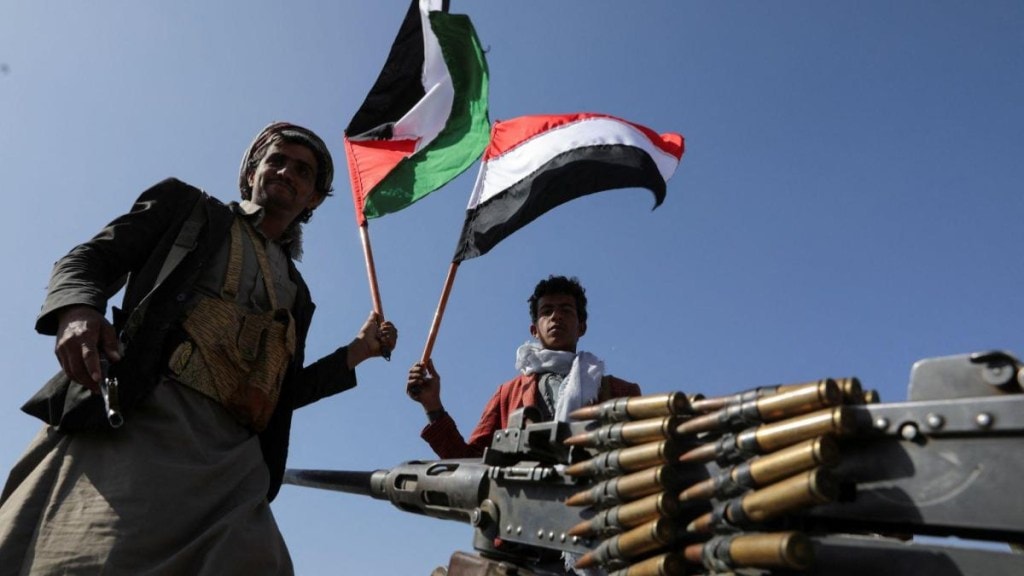In a bold escalation of hostilities, Yemen’s Houthi rebels have recently taken aim at American military forces in the Red Sea, claiming responsibility for multiple attacks that have inflicted significant damage. The Houthis have targeted high-value assets, including the US aircraft carrier USS Harry S. Truman, alongside Israeli military bases, signalling a troubling shift in the regional power dynamics.
Houthi Strike on the USS Harry S Truman
The USS Harry S. Truman, one of the most powerful aircraft carriers in the US Navy, has been at the center of the Houthis’ latest offensive. This aircraft carrier, capable of deploying more than 60 fighter jets simultaneously, including the advanced F-18 Super Hornet, represents a cornerstone of American naval power. Yet, the Houthis, backed by Iran, have claimed to have successfully targeted it with a mix of missiles and drones.
Yahya Sariya, a military spokesman for the Houthis, commented on the attack: “The American enemies were preparing to launch a major air attack on Yemen, but we targeted them before the US attack. Due to our attack, the American campaign failed.”
Though the USS Harry S. Truman is equipped with extensive defences, the Houthis’ missile and drone operations have proven to be an increasingly potent threat in the region. The attack comes at a time when American and allied forces have been heavily engaged in the Middle East, dealing with the repercussions of recent conflicts, particularly the attack on Israel by Hamas. The growing Houthi threat in the Red Sea has added another layer of complexity to the US military’s already strained operations in the region.
The Growing Impact of Houthi Attacks
The Houthis’ operations are causing substantial damage to US forces, both directly and indirectly. In the last year alone, the US Navy has reported the loss of several Predator drones, which were downed by Houthi missiles. Additionally, a US Navy fighter jet, an F-18 Super Hornet, was accidentally shot down by friendly fire during a clash with Houthi forces, highlighting the dangerous escalation in the region.
Despite these losses, neither the US nor Israel has publicly responded in full to the Houthi actions. The lack of a strong reaction raises questions about the US’s broader strategy in Yemen and the Red Sea, as well as its willingness to confront Iran-backed militant groups more directly.
Houthi Threats Against Israel
In addition to targeting US assets, the Houthis have also expanded their focus to Israeli military interests. Reports indicate that the group has launched drone strikes against two Israeli military bases in Tel Aviv and an important target in Ashkelon. Houthi spokespersons have threatened Israel, vowing to continue operations in support of Palestinians until the Israeli attacks on Gaza cease and the siege is lifted.
The Houthis’ support for Palestinian groups has long been a central part of their ideological platform. These recent attacks are a continuation of their longstanding rhetoric of resistance against Israeli military actions and their broader alignment with Iranian interests in the region. The threat of escalating Houthi attacks on Israel adds to the already volatile security situation in the Middle East.
Espionage and the Arrest of MI6 and Saudi Spies
Adding to the tension, recent reports from Yemen suggest a growing espionage campaign, with the Houthi rebels claiming to have captured British and Saudi spies operating within the country. A video recently surfaced showing the arrest of operatives allegedly working for British intelligence agency MI6 and Saudi intelligence agencies. According to the Houthis, these spies were involved in missions targeting Yemen’s strategic assets, including missile sites, military infrastructure, and high-ranking political figures.
The arrested operatives are said to have undergone training in Riyadh, where they were reportedly equipped with advanced communications technology to aid in their espionage operations. While these claims remain unverified by outside sources, they highlight the depth of intelligence operations in Yemen, where multiple international powers have vested interests.
The Growing Complexity of the Yemen Conflict
The Houthi attacks on American, Israeli, and allied targets signal an increasingly complex and dangerous environment in the Red Sea and broader Middle East. The rise of Houthi military capabilities, particularly their use of drones and missiles, has forced both US and Israeli military planners to reassess their strategies in the region. The involvement of external intelligence agencies, as suggested by the espionage arrests, indicates that Yemen is becoming an even more critical theater of global power struggles.
The strategic importance of Yemen and the Red Sea cannot be overstated. The Red Sea is a vital shipping route that connects the Mediterranean to the Indian Ocean, and Yemen’s position along this corridor makes it a key player in global trade and military strategy. As the Houthis continue to assert their influence with growing military capabilities and diplomatic support from Iran, the threat to both regional and global stability becomes more pronounced.
A Regional Powder Keg
The Houthis’ actions in the Red Sea and beyond underscore the increasingly multifaceted nature of the Yemen conflict. With growing military sophistication, strategic targeting of US and Israeli assets, and a web of international espionage, the Houthis are becoming a formidable force that is not only challenging American and Israeli military supremacy but also threatening the broader geopolitical order. As the situation continues to evolve, it is clear that the Houthis are no longer just a local insurgent group but a central player in the Middle East’s power dynamics.

